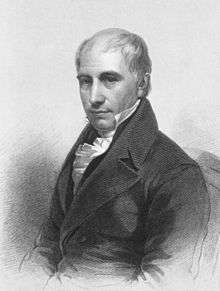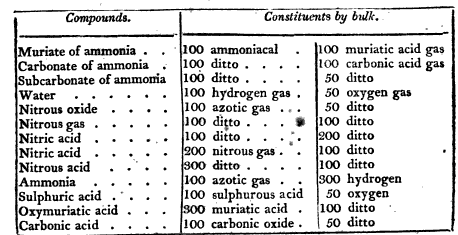Thomas Thomson (chemist)

Thomas Thomson (12 April 1773 – 2 July 1852) was a Scottish chemist and mineralogist whose writings contributed to the early spread of Dalton's atomic theory.
He was the inventor of the saccharometer. Furthermore, he gave silicon its current name.
He served as president of the Philosophical Society of Glasgow.
Thomson was the father of the botanist Thomas Thomson, and the uncle and father-in-law of the Medical Officer of Health Robert Thomson.
Life and work
Thomas Thomson was born in Crieff in Perthshire, in 1773. He was educated at the High School of Dundee before moving to the University of St. Andrews to study in classics, mathematics, and natural philosophy. He went on to graduate in medicine from the University of Edinburgh in 1799. However, he was inspired by Joseph Black to take up the study of chemistry.

In 1796, Thomson succeeded his brother, James, as assistant editor of the Supplement to the Third Edition of the Encyclopædia Britannica, contributing the articles Chemistry, Mineralogy, and Vegetable, animal and dyeing substances. In 1802, Thomson used these articles as the basis of his book System of Chemistry. His book Elements of Chemistry, published in 1810, displayed how volumes of different gasses react in a way in a way that supported the atomic theory. He also wrote the article "Chemistry" for the 7th edition of Britannica, published in 1842.
Thomson dabbled in publishing, acted as a consultant to the Scottish excise board, invented the instrument known as Allan's saccharometer, and opposed the geological theories of James Hutton, founding the Wernerian Natural History Society of Edinburgh as a platform in 1808. In Mar 1811 he was elected a Fellow of the Royal Society[1] and in 1815 was elected a corresponding member of the Royal Swedish Academy of Sciences. In 1813 he founded Annals of Philosophy a leader in its field of commercial scientific periodicals.[2]
In 1817 he gave silicon its present name, rejecting the suggested "silicium" because he felt the element had no metallic characteristics, and that it chemically bore a close resemblance to boron and carbon.[3]
In 1817, Thomson became Lecturer in and subsequently Regius Professor of Chemistry at the University of Glasgow, retiring in 1841. In 1820 he identified a new zeolite mineral, named thomsonite in his honour.
Thomson died at Kilmun in 1852 and was buried at the Glasgow Necropolis.[4]
Honours
- Fellow of the Royal Society of Edinburgh (1805)
- Fellow of the Royal Society, (1811)
Selected writings
- Survey of Chemistry (1802)
- The Elements of Chemistry (1810)
- History of the Royal Society, from its institution to the end of the eighteenth century (1812)
- An Attempt to Establish the First Principles of Chemistry by Experiment (1825)
- History of Chemistry (1830)
- A System of Chemistry of Inorganic Bodies (1831)
- Chemistry of Animal Bodies (1843)
Notes
- ↑ "Library and Archive Catalogue". Royal Society. Retrieved 25 October 2010.
- ↑ Morrell, Jack. "Thomson, Thomas". Oxford Dictionary of National Biography (online ed.). Oxford University Press. doi:10.1093/ref:odnb/27325. (Subscription or UK public library membership required.)
- ↑ Thomas Thomson, A System of Chemistry in Four Volumes, 5th ed. (London, England: Baldwin, Cradock, and Joy, 1817), vol. 1. From page 252: "The base of silica has been usually considered as a metal, and called silicium. But as there is not the smallest evidence for its metallic nature, and as it bears a close resemblance to boron and carbon, it is better to class it along with these bodies, and to give it the name of silicon."
- ↑ "Thomas Thomson". Retrieved 8 September 2008.
References
-
 This article incorporates text from a publication now in the public domain: Chisholm, Hugh, ed. (1911). "Thomson, Thomas". Encyclopædia Britannica. 26 (11th ed.). Cambridge University Press.
This article incorporates text from a publication now in the public domain: Chisholm, Hugh, ed. (1911). "Thomson, Thomas". Encyclopædia Britannica. 26 (11th ed.). Cambridge University Press.
Further reading
- "Biographical notice of the late Thomas Thomson". Glasgow Medical Journal. 5: 69–80, 121–153. 1857.
- Crum, W. (1855). "Sketch of the life and labours of Dr Thomas Thomson". Proceedings of the Philosophical Society of Glasgow. 3: 250–264.
- Thomson, R.D. (1852–1853). "Memoir of the late Dr Thomas Thomson". Edinburgh New Philosophical Journal. 54: 86–98.
- Foundations of the atomic theory: comprising papers and extracts by John Dalton, William Hyde Wollaston, M. D., and Thomas Thomson, M. D. (1802–1808). Edinburgh: The Alembic Club. 1911.
External links
-
 "Thomson, Thomas (1773-1852)". Dictionary of National Biography. London: Smith, Elder & Co. 1885–1900.
"Thomson, Thomas (1773-1852)". Dictionary of National Biography. London: Smith, Elder & Co. 1885–1900. - "Thomas Thomson". Retrieved 8 September 2008.
- "Significant Scots". Retrieved 8 September 2008.